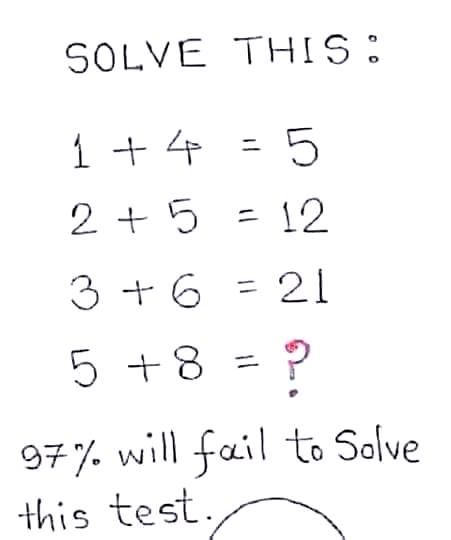
In recent times, a puzzling math challenge has been circulating on social media, leaving many scratching their heads. The challenge presents a series of seemingly simple arithmetic equations with an unusual twist. The image typically reads:

The intrigue lies not in the arithmetic operations themselves, but in the pattern hidden behind the numbers. At first glance, the equations defy conventional arithmetic rules. However, a deeper look reveals a clever pattern that, once understood, makes the puzzle quite solvable. Let’s dive into the logic and unveil the method used to crack this puzzle.
Step-by-Step Breakdown
The key to solving this puzzle is recognizing that the equations follow a cumulative pattern rather than straightforward addition. Here’s how you can break it down:
First Equation: 1 + 4 = 5
This equation seems straightforward at first, as 1 + 4 does indeed equal 5. However, it sets the stage for the cumulative pattern.
Second Equation: 2 + 5 = 12
To understand this, notice that 2 + 5 equals 7. However, the answer provided is 12, which is 7 added to the result of the previous equation (5).
So, 7 (2 + 5) + 5 (previous result) = 12.
Third Equation: 3 + 6 = 21
Similarly, 3 + 6 equals 9. Adding this to the previous result (12) gives us 21.
So, 9 (3 + 6) + 12 (previous result) = 21.
Applying the Pattern
Now that the pattern is clear, let’s apply it to the final equation:
Fourth Equation: 5 + 8 = ?
Following the established pattern, 5 + 8 equals 13.
Adding this to the previous result (21) gives us the final answer.
So, 13 (5 + 8) + 21 (previous result) = 34.
Conclusion
The solution to the final equation, 5 + 8, is 34 when following the cumulative pattern identified in the previous equations. The challenge, therefore, isn’t just about simple addition but understanding and recognizing the pattern used to derive each subsequent result.
This puzzle highlights an essential aspect of problem-solving: sometimes, the solution requires looking beyond the obvious and exploring hidden patterns. While 97% of people might initially fail to solve this test due to its deceptive simplicity, once the underlying method is revealed, it becomes an engaging and enjoyable mental exercise.
Why Puzzles Like This Matter
Puzzles and brain teasers such as this one are more than just social media trends; they play a vital role in cognitive development. They encourage critical thinking, pattern recognition, and the ability to approach problems from different angles. This particular puzzle demonstrates how breaking down complex problems into simpler parts and observing patterns can lead to a solution, a valuable skill in many areas of life.
In conclusion, the answer to the viral math challenge “5 + 8 = ?” is 34. The method involves adding the current numbers and then summing that result with the outcome of the previous equation. It’s a fantastic reminder that sometimes, solutions require thinking outside the box and looking for patterns beyond the obvious. So, the next time you encounter a seemingly unsolvable puzzle, take a step back and search for the hidden logic—it’s there, waiting to be discovered.


